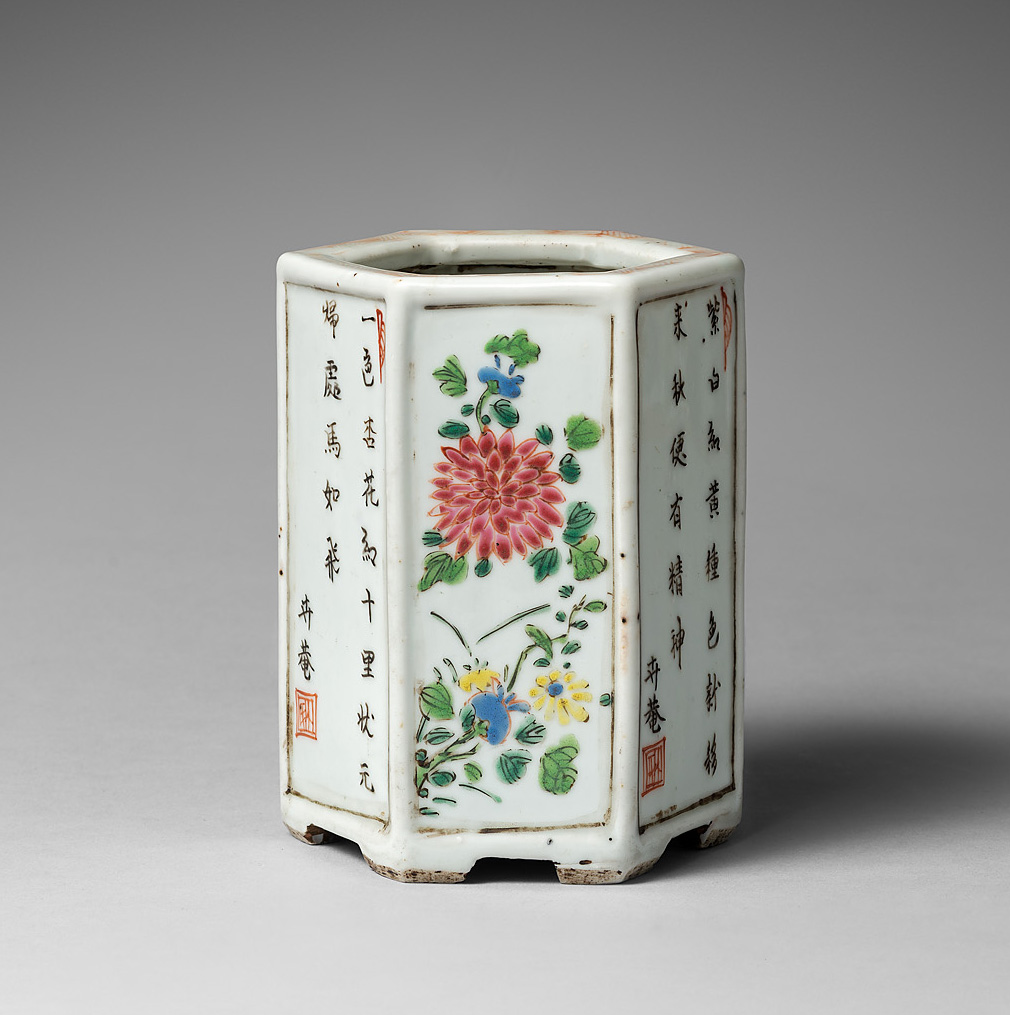Additonal informations :The inscribed verses are as follows
« 一色杏花红十里,状元归去马如飞 »
The blossoming apricot trees tint the mountains and plains with a brilliant red, stretching across entire leagues. The newly crowned laureate of the imperial examinations returns triumphantly to his hometown, riding at a gallop, exuding elegance and grace. This couplet constitutes a reworking of a line by Su Shi, taken from his poem “Ti Yunlongshan Fangheting” (题云龙山放鹤亭), composed at the end of the Song dynasty: “一色杏花三十里,新郎君去马如飞.” Through a floral allusion to spring, the version inscribed on the brush holder substitutes the figure of the xinlang jun (新郎君, “young bridegroom”) with that of the zhuangyuan (状元, “top laureate of the imperial examinations”), thus embodying the ideal of academic success and social ascent. Charged with a strong meritocratic imagery, this verse was widely disseminated, both in popular circles and in the studios of scholars, becoming a recurring motif in decorative objects related to the scholarly realm.
« 紫白红黄种色新,移来秋便有精神 »
The purple, white, red, and yellow flowers display fresh and vibrant colors. Even when transplanted elsewhere, they retain their vitality and brilliance, even in autumn. This line is borrowed from the first chapter of Yu Jiaoli (玉娇梨), a novel from the late Ming or early Qing era. It celebrates the multicolored beauty of chrysanthemums, which are capable of preserving their luster even in the late season. By extension, this floral imagery becomes a moral metaphor: it illustrates the ideal of the persevering scholar, who remains dignified and resilient in the face of adversity. Thus, it resonates with the spiritual elevation sought in the culture of wenfang (文房, “scholar’s desk”), where floral aesthetics are coupled with an ethical significance.
« 富贵一慕千金价,暮春深惹玉堂风 »
This flower, a symbol of wealth and nobility, is so coveted that it is deemed worthy of a thousand pieces of gold. Even at the end of spring, it continues to attract attention and fill the refined residences with its fragrance. This verse loosely reinterprets an image drawn from Han Cong (韩琮) in a Tang dynasty poem dedicated to the peony: “晓艳远分金掌露,暮香深惹玉堂风.” In this adaptation, the reference to yutang feng (玉堂风) — literally “the wind of the Jade Pavilion,” a refined metaphor associated with the floating fragrance in elegant abodes — is preserved, yet enriched by terms such as fugui (富贵, “wealth and nobility”) and qianjin (千金, “a thousand pieces of gold”), explicitly reinforcing the imagery of social ascent. This verse thus crystallizes the scholarly ideal of elegance, distinction, and aspiration to refinement, in a culture where floral beauty becomes the poetic expression of a desired status.
Overall, this brush holder closely articulates the formal and poetic dimensions of painting and calligraphy. It reflects recurring themes of Chinese literati culture, such as the appreciation of flowers, the relationship with natural rhythms, the ideals of career, and moral values. By merging utilitarian function with symbolic content, this object exemplifies the interactions between daily practice, artistic expression, and the intellectual framework characteristic of the literati milieu.
“Huì’ān” (卉菴) is a mark on porcelain from the Qing dynasty.
The term Huì’ān, transcribed in pinyin, can refer either to a type of mark known as tángmíng kuǎn (堂名款), which designates the name of a pavilion or private studio, or to a type of mark called rénmíng kuǎn (人名款), meaning a proper name associated with an individual. Tángmíng kuǎn marks typically reference private residences, study pavilions, or literati studios, whose names are inscribed, painted, or engraved on porcelains intended for personal use, ceremonial functions, or as collectibles. Such designations include terms like táng (堂 – hall), zhāi (斋 – retreat), xuān (轩 – pavilion), shì (室 – chamber), shūfáng (书房 – study), lóu (楼 – floor), or gé (阁 – cabinet).
On the other hand, rénmíng kuǎn marks correspond to the names of workshop owners, artisans, patrons, collectors, or supervisors associated with the production or oversight of the piece. The Huì’ān mark primarily appears on porcelain dated to the reign of Emperor Kangxi (1662–1722), although it is also attested during the Yongzheng reign (1723–1735). This recurrence may suggest that it was a favored studio name among the literati of that era, or possibly a personal name linked to a figure in ceramic production in Jingdezhen during the early Qing dynasty.
